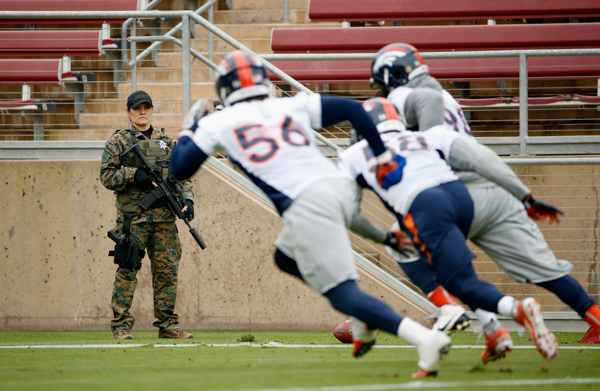Football stadiums that range in capacity from a few hundred to more than 100,000 are routinely filled with some of sports’ more ardent fans. The parties begin early in sprawling parking lots and fields — well before fans enter the high-security confines of the stadium. Per NFL and NCAA statistics, more than 17 million and almost 50 million fans, respectively, attended football games in the 2015 season.
Each one of these games — known in the event and security world as assembly events — is a soft target for incidents triggered by accident or on purpose. The Department of Homeland Security considers any assembly of 350 or more people to be soft targets for terrorism. The atrocity in Paris at the Stade de France in 2015 reminded us that these events are not immune to acts of terror — foreign or domestic, coordinated or lone wolf, in the name of something big or small.
Sports stadiums have long had security plans, identifying when and where security personnel need to be in position; identifying situations before they get out of control; transporting transgressors to the holding cell or out of the stadium. These facilities also have had evacuation plans in cases of emergency situations such as dangerous weather and fire.
In September, severe weather in Nashville tested Vanderbilt Stadium as it was successfully evacuated before a football game against Middle Tennessee State. In Minneapolis, the University of Minnesota’s TCF Bank Stadium had to evacuate thousands of Beyoncé fans before a concert due to severe weather.
Simply put, an incident pre-plan is a published summary of all critical building, property and footprint information required by first responders in the event of an emergency. Assembly events need to be incident pre-planned so first responders can react with knowledge, saving lives and property.
But the idea of a comprehensive, event-centric incident pre-plan is still less than a decade old. The Arlington Fire Department understood in 2007 as the new Dallas Cowboys stadium was under construction that it could not continue to properly defend the sports complex without a pre-plan. A well-thought-out incident pre-plan was developed between 2007 and 2009 to ensure fans enjoying either a Cowboys game or a Rangers game would receive optimum emergency response when required.
 |
Stadiums have long had security plans, identifying when and where personnel need to be in position.
Photo by: GETTY IMAGES
|
A pre-plan answers nearly every question a first responder may have about the site. What do the facility floor plans look like? What are the key characteristics of the surrounding property and parking lots? Where are exits and escape routes? Where are utility shut-off locations? Are there hazardous materials on-site? What attendees may have special needs and where are they? Are there safe rooms? How is the campus or the neighborhood laid out? Are visuals available through an existing security camera network? Are there pictures of the facility available?
Pre-plans have been a staple of fire department operations for years. Traditionally, a walk-through of a property was then translated onto paper and stuffed into a binder. This binder became a reference bible for fire department personnel when responding to an incident. Technology started playing a role as firefighters adopted computer-aided drawing programs for more accurate images. Those drawings were then printed out and put into the binder.
More recently, all-digital pre-plan programs have become available that make a quantum leap in ease-of-use and shareability by both property owners and first responders alike. These programs allow for a faster input of data, with greater detail. Same-day changes to the property or surrounding area can be added to the pre-plan. And since all of the information is accessed on laptops and tablets, first responders can get the latest, greatest information en route to the incident. Importantly, digital pre-plans are shareable between event/facility operators and first responders.
Busch Stadium in St. Louis and Loyola University Chicago’s Gentile Arena are two facilities captured in a digital pre-plan. Busch Stadium is part of the St. Louis Fire Department effort over the last few years to digitize pre-plans for all “target hazard” buildings across the municipality. Gentile Arena has been included in Loyola’s effort to digitally pre-plan the entirety of its three campuses to assist Chicago first responders in cases of emergency.
Having immediate, shareable answers is important as first responders in your area may have never conducted a walk-through of your event footprint or facility. And since many fire and police departments in the U.S. respond via “mutual aid” agreements, many first responders may have no knowledge of your event layout or facility prior to the 911 call.
In each of these cases, the pre-plan needs to be incorporated into event, facility and municipality emergency response plans. The plan needs to work side by side with security cameras, detectors, alarms, communications systems and human intelligence to create an holistic response to emergency situations.
In the end, a pre-plan helps mitigate the impact on lives and property when that good time — in the sun or under the lights — comes to an abrupt end.n
Stephen Nardi is CEO of RealView, developers of the CommandScope all digital pre-plan technology. For more information, visit www.realviewllc.com.





